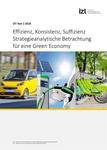Efficiency, consistency, sufficiency
Abstract
In the debate on sustainable management, three possible guiding strategies are discussed: Efficiency, consistency and sufficiency. In short, efficiency stands for fewer resource units per service unit, consistency for nature-friendly technologies and structures, and sufficiency for the reduction of burdensome consumption. There are differing views and sometimes heated debates about the definitions and delimitations as well as the significance of these strategies for the transformation of the green economy to be striven for in the economy and society and their relationship to a 2 green economy. The efficiency strategy is considered to be particularly compatible with the economy and is practised in numerous forms. An increase in resource productivity, raw material and energy efficiency is economically and ecologically advantageous, i.e. it saves costs economically and minimises the burden on the environment. In the meantime, this connection is reflected in a dynamic development of the global green tech markets, whose "volume is reaching a completely new dimension" (BMUB 2014). The efficiency strategy is even credited with an "efficiency revolution". Other actors, however, are much less euphoric, even sceptical, and attach a subordinate importance to the efficiency strategy. They point to rebound effects that reduce or even overcompensate for efficiency gains (Santarius 2012, Paech 2012). Consistency is therefore discussed as a more fundamental, systemic approach. It is believed to have a wider reach and greater impact. While the efficiency strategy is quantity-oriented - less resource consumption with more yield - the consistency strategy aims to change the quality of material and energy flows. This refers to substances, products and technologies that are compatible, i.e. consistent, with natural material cycles (Schmidt 2008). In essence, it is about the "creation of a metabolically nature-integrated industrial ecology through the basis-innovative conception and constitution of technical 'system changes', i.e. the set-up and later take-off of new technologies on new paths" (Huber 1999, 13). In his book "Intelligent wachsen" (2013), Fücks argues for "a fundamental change in the prevailing mode of production", i.e. for a "green industrial revolution" that focuses not only on efficiency but above all on consistency. Such processes are expected to have great problem-solving potential. Some authors assume that it can bring "by far the highest degree of sustainable problem solving" (Huber 1999). There is a particularly passionate debate about the status of sufficiency. While one faction claims that sufficiency has "not only a relatively low savings potential" but also "far too little socio-cultural connection and resonance potential" (Huber 1999; see also Fücks 2013), the other faction comes to the assessment: "Sufficiency is a necessary building block in an equally necessary ensemble of different sustainability strategies" (Fischer et al. 2013). Sufficiency is even seen as an "elegant solution" where efficiency and consistency reach their limits. At the societal level, a "consistent socio-ecological transformation of production and lifestyle and a democratically organised reduction of production and con---- 1See project definition paper, also in particular WBGU 2011, Grießhammer/Brohmann 2015 2See project definition paper 3See for example Huber 2014, Linz 2014 and Spangenberg 2013 6 1 INTRODUCTION sum" (Schmelzer/Passadakis 2011) is seen as necessary. The concept "of the post-growth economy is oriented towards a sufficiency strategy and the partial dismantling of industrial value creation processes, especially those based on the global division of labour, in favour of strengthening local and regional patterns of self-sufficiency" (Paech 2012). A "transformation design" is called for, which aims at a "completely different life". "Reuse, repurpose, share" is the credo of a new, "reductive modernity", which explicitly requires and entails cultural changes (Welzer 2014). The discussion on the three basic strategies of sustainability is receiving a current boost from the discourse on "post-growth", since in this context there is discussion about areas of future growth and its type and quality, as well as the necessary concepts and approaches (e.g. Adler 2014, Hunecke 2013, Paech 2012, Welzer 2011). Furthermore, the issue of sustainability and path change takes on particular importance in an international perspective, as it is not possible to generalise Western production and lifestyle patterns, and the recently defined Sustainable Development Goals (SDGs) also represent a major challenge for the EU states and their achievement must be made possible (Messner 2015, Altvater 2015, Wuppertal Institute 2005 and Steffen et al. 2015). While the scientific, social and political debate to date has essentially highlighted the advantages and disadvantages of the respective strategies, marking positions and dividing lines (e.g. efficiency and consistency versus sufficiency or vice versa), there is a lack of comparative analysis and classification of the transformation potentials for a Green Economy that also takes their interactions into account and links them conceptually, i.e. elaborates the complementary functions and potentials. With this in mind, this paper aims to provide a heuristic framework.
